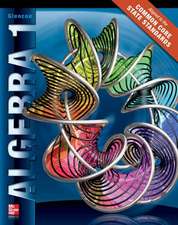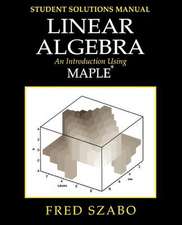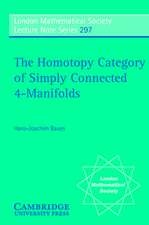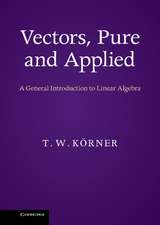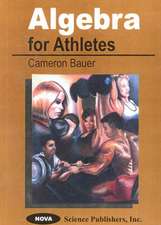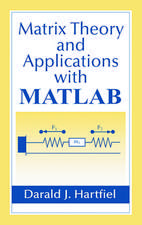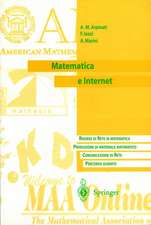Precalculus, Global Edition
Autor Michael Sullivanen Limba Engleză Paperback – 20 feb 2023
Prepare. Practice. Review.
Michael Sullivans time-tested approach focuses students on the fundamental skills they need for the course: preparing for class, practicing with homework, and reviewing the concepts. The 11th Edition continues to evolve to meet the needs of todays students.
This series prepares and supports students with access to help, where and when they require it. The hallmark Sullivan cycle of continuous preparation and retention along with the high-quality exercises that Sullivan texts are known for gives students the reinforcement they need.
Also available with MyLab Math
MyLab Math is the teaching and learning platform that empowers you to reach every student. By combining trusted author content with digital tools and a flexible platform, MyLab Math personalizes the learning experience and improves results for each student. Learn more about MyLab Math.
Preț: 490.98 lei
Preț vechi: 564.34 lei
-13% Nou
Puncte Express: 736
Preț estimativ în valută:
93.95€ • 98.54$ • 78.21£
93.95€ • 98.54$ • 78.21£
Carte disponibilă
Livrare economică 11-25 martie
Livrare express 25 februarie-01 martie pentru 98.35 lei
Preluare comenzi: 021 569.72.76
Specificații
ISBN-13: 9781292444529
ISBN-10: 1292444525
Pagini: 1200
Dimensiuni: 221 x 276 x 47 mm
Greutate: 2.51 kg
Ediția:11. Auflage
Editura: Pearson
ISBN-10: 1292444525
Pagini: 1200
Dimensiuni: 221 x 276 x 47 mm
Greutate: 2.51 kg
Ediția:11. Auflage
Editura: Pearson
Notă biografică
Mike Sullivan recently retired as Professor ofMathematics at Chicago State University, having taught there for more than 30years. He received his PhD in mathematics from Illinois Institute ofTechnology. He is a native of Chicagos South Side and currently resides in OakLawn, Illinois. Mike has four children; the two oldest have degrees inmathematics and assisted in proofing, checking examples and exercises, andwriting solutions manuals for this project. His son, Mike Sullivan, III,co-authored the Sullivan Graphing with Data Analysis series as well as thisseries. Mike has authored or co-authored more than ten books. He owns a travelagency, and splits his time between a condo in Naples, Florida and a home inOak Lawn, where Mike enjoys gardening.
Mike Sullivan, III is a professor of mathematics atJoliet Junior College. He holds graduate degrees from DePaul University in bothmathematics and economics. Mike is an author or co-author on more than 20books, including a statistics book and a developmental mathematics series. Mikeis the father of three children and an avid golfer who tries to spend as muchof his limited free time as possible on the golf course.
Mike Sullivan, III is a professor of mathematics atJoliet Junior College. He holds graduate degrees from DePaul University in bothmathematics and economics. Mike is an author or co-author on more than 20books, including a statistics book and a developmental mathematics series. Mikeis the father of three children and an avid golfer who tries to spend as muchof his limited free time as possible on the golf course.
Cuprins
1. Graphs
1.1 The Distance and Midpoint Formulas 1.2 Graphs of Equations in Two Variables; Intercepts; Symmetry 1.3 Lines 1.4 CirclesChapter 1 Review, Test, and Projects
2. Functions and Their Graphs
2.1 Functions 2.2 The Graph of a Function 2.3 Properties of Functions 2.4 Library of Functions; Piecewise-defined Functions 2.5 Graphing Techniques: Transformations 2.6 Mathematical Models: Building FunctionsChapter 2 Review, Test, and Projects
3. Linear and Quadratic Functions
3.1 Properties of Linear Functions and Linear Models 3.2 Building Linear Models from Data 3.3 Quadratic Functions and Their Properties 3.4 Build Quadratic Models from Verbal Descriptions and from Data 3.5 Inequalities Involving Quadratic FunctionsChapter 3 Review, Test, and Projects
4. Polynomial and Rational Functions
4.1 Polynomial Functions 4.2 Graphing Polynomial Functions; Models 4.3 Properties of Rational Functions 4.4 The Graph of a Rational Function 4.5 Polynomial and Rational Inequalities 4.6 The Real Zeros of a Polynomial FunctionChapter 4 Review, Test, and Projects
5. Exponential and Logarithmic Functions
5.1 Composite Functions 5.2 One-to-One Functions; Inverse Functions 5.3 Exponential Functions 5.4 Logarithmic Functions 5.5 Properties of Logarithms 5.6 Logarithmic and Exponential Equations 5.7 Financial Models 5.8 Exponential Growth and Decay Models; Newtons Law; Logistic Growth and Decay Models 5.9 Building Exponential, Logarithmic, and Logistic Models from DataChapter 5 Review, Test, and Projects
6. Trigonometric Functions
6.1 Angles, Arc, Length, and Circular Motion 6.2 Trigonometric Functions: Unit Circle Approach 6.3 Properties of the Trigonometric Functions 6.4 Graphs of the Sine and Cosine Functions 6.5 Graphs of the Tangent, Cotangent, Cosecant, and Secant Functions 6.6 Phase Shift; Sinusoidal Curve FittingChapter 6 Review, Test, and Projects
7. Analytic Trigonometry
7.1 The Inverse Sine, Cosine, and Tangent Functions 7.2 The Inverse Trigonometric Functions (Continued) 7.3 Trigonometric Equations 7.4 Trigonometric Identities 7.5 Sum and Difference Formulas 7.6 Double-angle and Half-angle Formulas 7.7 Product-to-Sum and Sum-to-Product FormulasChapter 7 Review, Test, and Projects
8. Applications of Trigonometric Functions
8.1 Right Triangle Trigonometry; Applications 8.2 The Law of Sines 8.3 The Law of Cosines 8.4 Area of a Triangle 8.5 Simple Harmonic Motion; Damped Motion; Combining WavesChapter 8 Review, Test, and Projects
9. Polar Coordinates; Vectors
9.1 Polar CoordinatesChapter 9 Review, Test, and Projects
9.2 Polar Equations and Graphs
9.3 The Complex Plane; De Moivres Theorem
9.4 Vectors
9.5 The Dot Product
9.6 Vectors in Space
9.7 The Cross Product
10. Analytic Geometry
10.1 Conics 10.2 The Parabola 10.3 The Ellipse 10.4 The Hyperbola 10.5 Rotation of Axes; General Form of a Conic 10.6 Polar Equations of Conics 10.7 Plane Curves and Parametric EquationsChapter 10 Review, Test, and Projects
11. Systems of Equations and Inequalities
11.1 Systems of Linear Equations: Substitution and Elimination 11.2 Systems of Linear Equations: Matrices 11.3 Systems of Linear Equations: Determinants 11.4 Matrix Algebra 11.5 Partial Fraction Decomposition 11.6 Systems of Nonlinear Equations 11.7 Systems of Inequalities 11.8 Linear ProgrammingChapter 11 Review, Test, and Projects
12. Sequences; Induction; the Binomial Theorem
12.1 Sequences 12.2 Arithmetic Sequences 12.3 Geometric Sequences; Geometric Series 12.4 Mathematical Induction 12.5 The Binomial TheoremChapter 12 Review, Test, and Projects
13. Counting and Probability
13.1 Counting 13.2 Permutations and Combinations 13.3 ProbabilityChapter 13 Review, Test, and Projects
14. A Preview of Calculus: The Limit, Derivative, and Integral of a Function
14.1 Finding Limits Using Tables and Graphs 14.2 Algebra Techniques for Finding Limits 14.3 One-sided Limits; Continuous Functions 14.4 The Tangent Problem; The Derivative 14.5 The Area Problem; The IntegralChapter 14 Review, Test, and Projects
Appendix A: Review A.1 Algebra Essentials A.2 Geometry Essentials A.3 Polynomials A.4 Synthetic Division A.5 Rational Expressions A.6 Solving Equations A.7 Complex Numbers; Quadratic Equations in the Complex Number System A.8 Problem Solving: Interest, Mixture, Uniform Motion, Constant Rate Job Applications A.9 Interval Notation; Solving Inequalities A.10 nth Roots; Rational Exponents
Appendix B: Graphing Utilities B.1 The Viewing Rectangle B.2 Using a Graphing Utility to Graph Equations B.3 Using a Graphing Utility to Locate Intercepts and Check for Symmetry B.4 Using a Graphing Utility to Solve Equations B.5 Square Screens B.6 Using a Graphing Utility to Graph Inequalities B.7 Using a Graphing Utility to Solve Systems of Linear Equations B.8 Using a Graphing Utility to Graph a Polar Equation B.9 Using a Graphing Utility to Graph Parametric Equations
Answers Credits Index

